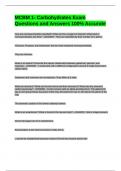Questions and Answers 100% Accurate
How are monosaccharides classified? What are the 3 sugars of interest? What kind of
monosaccharides are they? - ANSWER - They are classified by their number of C atoms.
*Glucose, Fructose, and Galactose* are the most important monosaccharides.
They are hexoses
What is an epimer? Describe the epimer relationship between galactose, glucose, and
mannose. - ANSWER - 2 molecules with a different configuration around a single asymmetric
carbon atom.
Galactose and mannose are not epimers. They differ at 2 sites.
What are anomers? What are the two forms and their structures? What was the anomeric
carbon previously? - ANSWER - Cyclic isomers with an alpha and beta form. The alpha form
has an OH group below the plane of the ring, the beta form has on OH above the plane of the
ring.
The anomeric carbon is the former carbonyl carbon.
What is an enantiomer? What is found in the human body? - ANSWER - Mirror image isomers.
Almost all sugars are D in enantiomers.
Racemization is the interconversion of D&L forms.
L cannot be metabolized because it doesn't fit into the enzyme active site!
, What are polysaccharides? How big are they? What are the most common ones? - ANSWER -
They can be 3-1000+ long. Common ones are glycogen, starch, and cellulose.
Discuss the function and bonds of Glycogen. What kind of bonds exist in them? - ANSWER -
They can have different types of glycosidic bonds within the same molecule.
alpha (1-4) in chain, alpha (1-6) at branchpoints. Both between glucose.
Discuss the function and bonds of Starch. What kind of bonds exist in them? - ANSWER -
Unbranched alpha (1-4)
Branched alpha (1-4) and alpha (1-6)
Discuss the function and bonds of Cellulose . What kind of bonds exist in them? - ANSWER -
We cannot break down Beta (1-4) bonds!
What are the 4 most important disaccharides? What are they made up of? What are they linked
by? What are these bonds created by? - ANSWER - Sucrose: Glucose+Fructose (table sugar)
Lactose: Galactos+Glucose (milk&dairy products)
Maltose: Glucose+Glucose
Isomaltose: Glucose+Glucose
Glycosytransferases make glycosidic bonds.
Discuss the components of glycosidic bonds. Using Galactose Beta (1-4) glucose as an
example, what does each thing stand for? - ANSWER -
What kind of bond does Sucrose have? What are the 2 monomers that make it up? - ANSWER -
Glucose and Fructose



